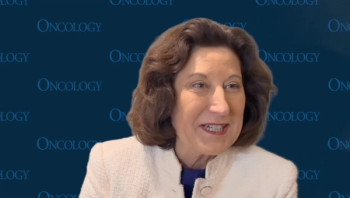
- Oncology Vol 30 No 4_Suppl_1
- Volume 30
- Issue 4_Suppl_1
(S008) The Effect of Simulation and Treatment Delays for Patients With Oropharyngeal Cancer Receiving Definitive Radiation Therapy in the Era of Risk Stratification Using Smoking and Human Papilloma Virus Status
Increasing time from diagnosis to simulation and from simulation until the start of therapy is associated with worse outcomes. Patients with HPV-associated oropharyngeal squamous cell carcinoma are at increased risk of nodal progression before treatment.
Mark Jeffry Amsbaugh, MD, Mehran Yusuf, BA, Elizabeth Cash, PhD, Craig Silverman, MD, Neal Dunlap, MD; University of Louisville
PURPOSE: To determine the effect of treatment delays for patients receiving radiation therapy for oropharyngeal squamous cell carcinoma (OPSCC).
MATERIALS AND METHODS: We examined patients seen in our multidisciplinary clinic from 2009 to 2014 with a diagnosis of OPSCC from a prospective database. Nodal tumor volumes were compared with staging imaging to identify nodal progression (higher N stage or more involved cervical lymph node levels). Chi-square, logistic, and Cox proportional hazards models were used to identify predictive factors and generate survival estimates. Spearman correlations and receiver operating characteristic (ROC) curves were used to characterize relationships between delays and outcomes.
RESULTS: Median elapsed times from staging to simulation, simulation to treatment start, and treatment start to treatment completion were 35, 10, and 44 days, respectively, for 156 patients. Sixty-eight patients (43.6%) exhibited nodal progression at the time of simulation. Patients with human papilloma virus (HPV)-associated OPSCC were more likely to have nodal progression (odds ratio [OR], 2.818 [95% CI, 1.292–6.146]), with increased odds seen among patients with intermediate-risk disease (OR, 3.194 [95% CI, 1.372–7.436]). Increasing time from staging to simulation was associated with nodal progression (P < .001), which placed patients at greater risk for distant failure (hazard ratio [HR], 3.682 [95% CI, 1.311–10.337]). An optimal cut point of 32 days from staging to simulation was established, with a sensitivity of 77.9% and a specificity of 60.2% for nodal progression. As time from simulation to the start of treatment increased, patients with nodal progression at simulation had greater risk of distant failure (HR, 3.958 [95% CI, 1.406–11.141]) and poorer progression-free survival (HR, 1.786 [95% CI, 1.008–3.165]).
CONCLUSIONS: Increasing time from diagnosis to simulation and from simulation until the start of therapy is associated with worse outcomes. Patients with HPV-associated OPSCC-specifically with intermediate-risk disease-are at increased risk of nodal progression before treatment.
Proceedings of the 98th Annual Meeting of the American Radium Society -
Articles in this issue
Newsletter
Stay up to date on recent advances in the multidisciplinary approach to cancer.















































































